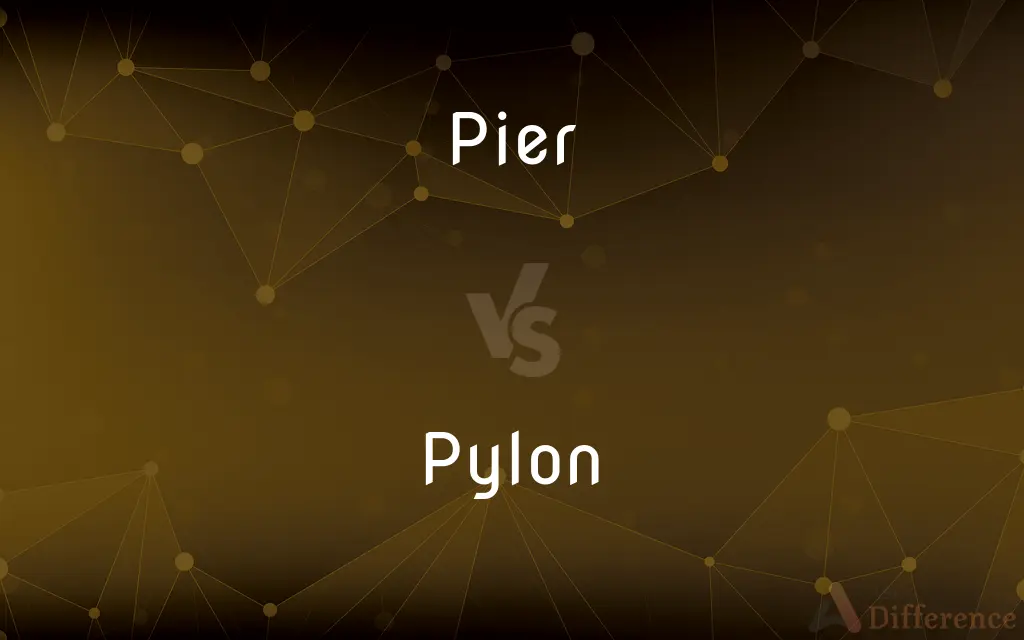Pier vs. Pylon — What's the Difference?
Edited by Tayyaba Rehman — By Maham Liaqat — Updated on March 28, 2024
A pier is a structure extending into a body of water, used for docking, fishing, or leisure, while a pylon is a vertical support or tower that can be part of a bridge, electrical line, or gate, primarily serving as a structural support.

Difference Between Pier and Pylon
Table of Contents
ADVERTISEMENT
Key Differences
A pier is essentially a raised structure, often made of wood, concrete, or metal, that projects from the shore into a body of water. It serves various purposes, including providing a docking area for boats and ships, offering a platform for fishing, or acting as a leisure spot for walking and sightseeing. Piers can be simple, extending a few meters into a lake or river, or elaborate constructions stretching far into the sea, sometimes featuring entertainment facilities, restaurants, and shops. On the other hand, a pylon is a tall, vertical structure designed to support or transmit something. In the context of bridges, pylons are the towering supports that carry the weight of the bridge deck, especially in suspension and cable-stayed designs. In electrical engineering, pylons refer to the tall towers that carry electrical cables over long distances. Additionally, pylons can serve as monumental gateways, like those found in ancient Egyptian architecture.
While both piers and pylons are engineering constructions that extend vertically, their functions and applications differ significantly. Piers are primarily about extending usable space into water for human activities or maritime purposes, emphasizing accessibility and interaction with water environments. Pylons, however, are focused on support or transmission, whether it be for structural integrity in bridges, distributing power across regions, or marking significant sites or boundaries.
The construction of a pier involves considerations about durability against water exposure, ease of access for people and vessels, and sometimes, the inclusion of amenities for public or commercial use. Pylon construction, conversely, prioritizes structural strength, height, and stability to fulfill its supporting role under varying loads and conditions, often requiring deep foundations and robust materials.
While piers are built to bring people into closer contact with water environments for a range of activities, pylons are constructed to uphold or convey essential elements of infrastructure, each playing a crucial role in their respective domains.
Comparison Chart
Primary Function
Extending into water for docking, fishing, leisure
Supporting structures like bridges, electrical lines
ADVERTISEMENT
Construction
Often made of wood, concrete, or metal
Typically constructed from steel or reinforced concrete
Usage
Maritime activities, public entertainment
Structural support, power transmission
Location
Along shores, into bodies of water
On land or water, where support is needed
Design Focus
Accessibility, durability against water, amenities
Height, structural strength, stability
Compare with Definitions
Pier
Often a site for leisure activities.
Families enjoyed the carnival rides and games on the seaside pier.
Pylon
Focuses on height and durability.
The new pylon design incorporated advanced materials for increased longevity.
Pier
A structure projecting into water for docking ships.
The old wooden pier has been a favorite fishing spot for generations.
Pylon
Carries electrical lines over distances.
Electrical pylons dotted the landscape. carrying power to remote areas.
Pier
Can feature amenities like shops and restaurants.
The pier's end had a renowned seafood restaurant with ocean views.
Pylon
A support tower for bridges.
The towering pylons of the suspension bridge were visible for miles around.
Pier
Serves as a key point for maritime transport.
Ferries to the island depart from the newly constructed pier.
Pylon
Integral to the structure’s stability.
Engineers inspected the pylons for signs of wear to ensure the bridge's safety.
Pier
Designed for easy access to water.
The rescue team launched their boat from the pier during the search operation.
Pylon
Can mark entrances or significant places.
The ancient temple was flanked by two monumental stone pylons.
Pier
Such a structure used predominantly for entertainment.
Pylon
A movable, brightly colored cone or shaft of rubber that is used to signal something to be avoided, such as a hazard or work zone on a roadway.
Pier
A pier is a raised structure that rises above a body of water and usually juts out from its shore, typically supported by piles or pillars, and provides above-water access to offshore areas. Frequent pier uses include fishing, boat docking and access for both passengers and cargo, and oceanside recreation.
Pylon
(Football) A flexible, usually padded marker that stands upright at each corner of the end zone to facilitate judgments of close plays.
Pier
A platform extending from a shore over water and supported by piles or pillars, used to secure, protect, and provide access to ships or boats.
Pylon
A tower marking a turning point in a race among aircraft.
Pier
A supporting structure at the junction of connecting spans of a bridge.
Pylon
A steel tower supporting high-tension wires.
Pier
A pillar, generally rectangular in cross section, supporting an arch or roof.
Pylon
A tower or shaft supporting a wind turbine.
Pier
The portion of a wall between windows, doors, or other openings.
Pylon
A structure supporting a bridge deck.
Pier
A reinforcing structure that projects from a wall; a buttress.
Pylon
A large structure or group of structures marking an entrance or approach.
Pier
A raised platform built from the shore out over water, supported on piles; used to secure, or provide access to shipping; a jetty.
Your boat is docked at the pier.
Pylon
A monumental gateway in the form of a pair of tapered blocks serving as the entrance to an ancient Egyptian temple.
Pier
A similar structure, especially at a seaside resort, used to provide entertainment.
There is a gaming arcade on the pier.
Pylon
A structure that attaches an aircraft engine to a plane's wing or fuselage.
Pier
A structure supporting the junction between two spans of a bridge.
Pylon
A gateway to the inner part of an Ancient Egyptian temple.
Pier
(architecture) A rectangular pillar, or similar structure, that supports an arch, wall or roof, or the hinges of a gate.
Pylon
(electricity) A tower-like structure, usually one of a series, used to support high-voltage electricity cables.
Pier
Any detached mass of masonry, whether insulated or supporting one side of an arch or lintel, as of a bridge; the piece of wall between two openings.
Pylon
(architecture) A tall steel or concrete tower from which cables are strung.
Pier
A projecting wharf or landing place.
Pylon
A lighting mast; a freestanding support for floodlights.
Pier
A platform built out from the shore into the water and supported by piles; provides access to ships and boats
Pylon
(aviation) A structure used to mount engines, missiles etc., to the underside of an aircraft wing or fuselage.
Pier
(architecture) a vertical supporting structure (as a portion of wall between two doors or windows)
Pylon
A starting derrick for an aeroplane.
Pier
A support for two adjacent bridge spans
Pylon
A post, tower, etc. as on an aerodrome, or flying ground, serving to bound or mark a prescribed course of flight.
Pylon
An obelisk.
Pylon
A traffic cone.
Pylon
(American football) An orange marker designating one of the four corners of the end zone in American football.
Pylon
(medicine) A rigid prosthesis for the lower leg.
Pylon
A low tower, having a truncated pyramidal form, and flanking an ancient Egyptian gateway.
Massive pylons adorned with obelisks in front.
Pylon
An Egyptian gateway to a large building (with or without flanking towers).
Pylon
A tower, commonly of steelwork, for supporting either end of a wire, as for a telegraph line, over a long span.
Pylon
Formerly, a starting derrick (the use of which is now abandoned) for an aeroplane.
Pylon
A tower for guiding pilots or marking the turning point in a race
Pylon
A large vertical steel tower supporting high-tension power lines;
Power pylons are a favorite target for terrorists
Common Curiosities
How do piers impact marine environments?
Piers can affect local ecosystems through shading, altering water flow, and providing habitats for marine life, necessitating careful ecological assessment during planning.
Are piers always open to the public?
While many piers are public spaces, some are privately owned and restricted to specific uses like commercial shipping or military operations.
How is the maintenance of piers and pylons managed?
Regular inspections and maintenance are crucial for both, involving repairs, replacements, and updates to materials and structural components to ensure longevity and safety.
Can piers and pylons be part of the same structure?
Yes, in certain bridge designs, piers (supporting columns in the water) work alongside pylons (vertical supports for the bridge deck) to provide stability.
Why are pylons often seen in pairs across highways or fields?
Pylons are used in pairs or series to support overhead power lines, ensuring consistent transmission of electricity across distances.
How have piers evolved over time?
Piers have evolved from simple wooden structures to complex, multi-use facilities incorporating entertainment, dining, and recreational activities, reflecting changes in technology, society, and leisure practices.
How do environmental considerations affect pier and pylon construction?
Environmental factors significantly influence the design and materials used in both, with piers requiring resistance to water and corrosion, while pylons must withstand wind, weight, and sometimes seismic activity.
Can the design of a pier or pylon become a landmark?
Yes, many piers and pylons have become iconic landmarks due to their historical significance, architectural beauty, or engineering marvel, like the Golden Gate Bridge’s pylons.
What challenges are involved in constructing pylons in water?
Constructing pylons in water involves challenges like ensuring stable foundations on the seabed, resisting corrosion, and dealing with the logistical complexities of underwater construction.
Do pylons have any symbolic significance?
In some cultures, pylons have symbolic meanings, representing gateways, power, and progress, especially monumental pylons in historical architectures.
What's the tallest pylon in the world?
The height of pylons can vary widely depending on their purpose, but some of the tallest are found in suspension bridges and transmission towers, reaching several hundred meters.
What materials are commonly used in the construction of modern piers?
Modern piers often use materials like reinforced concrete, steel, and sometimes advanced composites for durability and longevity.
How do weather conditions affect the design of pylons?
Pylon design must account for local weather conditions, including wind loads, ice accumulation, and temperature variations, to ensure structural integrity and safety.
Can a pier or pylon be relocated?
While relocation is theoretically possible, it is usually impractical and cost-prohibitive due to the complex engineering and environmental considerations involved in both pier and pylon structures.
What innovations are being made in pier and pylon construction?
Innovations include the use of eco-friendly materials, smart monitoring systems for maintenance, and designs that minimize environmental impact while enhancing durability and aesthetics.
Share Your Discovery

Previous Comparison
Contingency vs. Contiguity
Next Comparison
Clam vs. QuahogAuthor Spotlight
Written by
Maham LiaqatEdited by
Tayyaba RehmanTayyaba Rehman is a distinguished writer, currently serving as a primary contributor to askdifference.com. As a researcher in semantics and etymology, Tayyaba's passion for the complexity of languages and their distinctions has found a perfect home on the platform. Tayyaba delves into the intricacies of language, distinguishing between commonly confused words and phrases, thereby providing clarity for readers worldwide.
















































